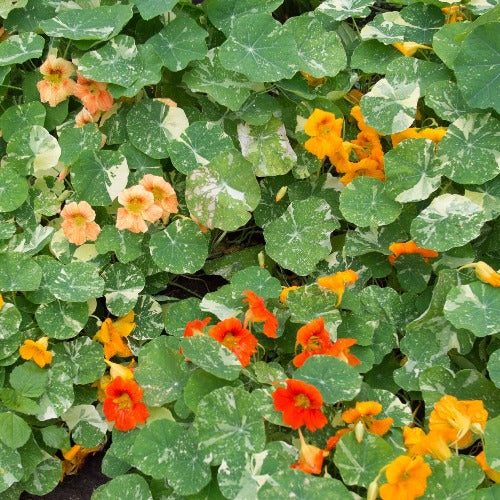Flower, Nasturtium, Alaska Mix
Couldn't load pickup availability
Nasturtium, Alaska Mix Tropaeolum nanum majus
Alaska Mix nasturtium seeds produce a Heavily variegated foliage with a mix of gold, orange, red, and yellow flowers. Considered a dwarf variety and is a beautiful must-have in your vegetable garden, also does well in both in beds and containers. Nasturtiums are easy to direct sow; they require little care but are happiest when grown in the cooler months with ample moisture. Flowers and leaves are edible with a flavor similar to arugula.
Nasturtium is very easy to grow. Mulching heavily around your plants will help with weed suppression and moisture retention. Harvest regularly or deadhead the flowers for more continuous blooms.
- Botanical Name - Tropaeolum nanum majus
- Zone - 2-10
- Seed to Harvest - 65 Days
- Height - 10-12"
- Fruit Weight-n/a
- Fruit Color - n/a
- Treated - No
- Germination Time - 7-10 Days
- Breed - Heirloom, Open Pollinated
- Germination Rate – 90%
- Lifecycle – Annual
- Sunlight - Full Sun / Partial Sun
- Watering – Average
- Sow Method – Direct Sow
- Sow Depth - 1/ 2 inch
- Plant Spacing - 6 inches
- Row Spacing – 8-12 inches
- Season of Interest - Cool / Warm
Planting in your zone:
Zones 2-8
Direct sow two weeks before the last frost or start indoors 3-4 weeks before the last frost
Zones 9-10
Nasturtium is a cool-season crop in Zones 9 and 10. Plant nasturtium from winter to spring. Seasonal rains followed by regular watering will keep the plant blooming from early spring through late summer. Best to direct seed in full sun.
Planting Nasturtium Seeds
To direct sow, individually plant, or broadcast seeds in debris-free, well-worked soil that has been deeply watered. Cover well with 1/2″ of finely sifted soil; seeds require darkness for germination. Scarifying (scratching) the seed coat to allow water in will help the seed take on the water quicker and germinate quicker. Nasturtium is not fussy and can be grown in poor, well-draining soil.
Harvesting Nasturtium
All parts of nasturtium have culinary applications. Ornate flowers and foliage have a spicy, peppery flavor. Leaves may be harvested for salads, pesto, dips, or even used in place of grape leaves for dishes similar to Greek dolmades. Young green seeds may be gathered and pickled like capers. Harvest fully open flowers at any time of day.
Growing in Containers
Nasturtium is a great plant to grow in a container. 3-5 plants are ideal for a hanging basket or container. Make sure your container is at least 10″ deep. Keep in mind containers will dry out faster because they have more surface area and less soil to hold onto moisture. Mulch heavily on the top layer of soil in the pot to keep the soil from drying out or heating up too much.
Companion Crops
Nasturtium is one of the first flowers to welcome spring to the garden, use it to attract pests away from your vegetable crops. Crops such as cucumber, squash, and tomato may benefit from nearby nasturtium. Butterflies and other pollinators love you for it too.


